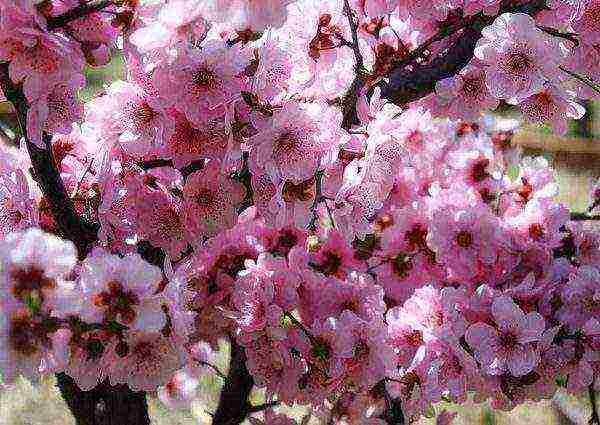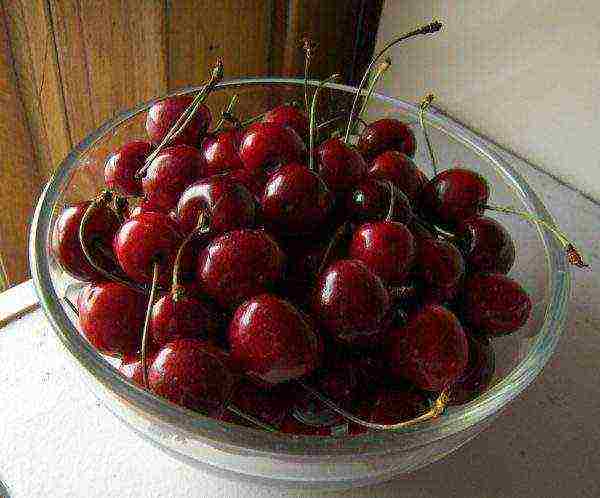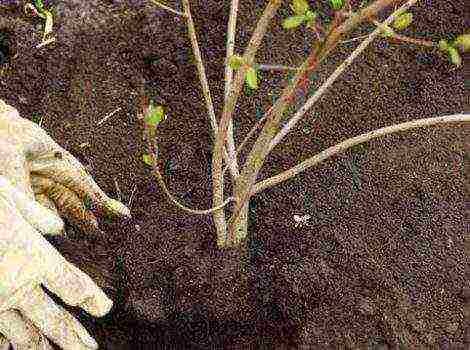Content
- 1 Correct planting and caring for columnar cherries
Correct planting and caring for columnar cherries
Yielding primacy in orchards to apple, cherry, plum and pear, sweet cherry does not lag behind in the selection of new varieties. Columnar trees occupy a special place.
They allow you to get a good harvest in the cramped conditions of a small garden. On an industrial scale, columnar cherries show high results in intensive farming conditions.
Characteristics and features of columnar cherries
Columnar cherry is a cylinder-shaped tree that only grows upward. The crown is formed by short lateral branches and does not exceed one meter in diameter. The peculiarity of lateral branches is a large number of fruit shoots and the absence of strong branching.
Advantages and disadvantages of columnar cherries
Columnar cherry gives a lot of advantages in growing on the site, namely:
- Decorativeness. Trees will preserve the integrity of any landscape direction in the design of the site. As a novelty in breeding, the varieties do not leave indifferent among enthusiastic gardeners.
- Compactness... Sweet cherries, due to the small diameter of the crown, allow you to use less space for fruit trees. They are easy to handle, trim and harvest.
- Early maturity and taste. The varieties were bred with the preservation of the main taste characteristics of classic sweet cherries. Technical ripeness in different varieties occurs from the beginning to the end of June and allows you to enjoy vitamins at the beginning of summer.

Planting columnar cherries
The seedlings are available for sale in garden centers, nurseries and online stores. It is better to stop the choice on a seller with a good reputation, who guarantees the compliance of the tree with varietal characteristics. Personal inspection will avoid disappointment. A good seedling has the following characteristics:
- The bud of the apical shoot is alive, without signs of damage.
- The trunk is straight, without distortion. The bark is smooth.
- There is no rot and dead tissue on the roots. The roots are alive.
- Leaves (if any) without damage and pests.
When purchasing several cherries, choose plants of the same age for the garden.
The landing itself depends on the region. In the northern regions, autumn planting is not recommended: the seedlings will not have time to take root and will freeze out. In the southern regions and central Russia, it can be planted in autumn and spring. Autumn planting is productive in the south: the tree takes root, goes through a period of adaptation and does not get sick in the spring.
When choosing a place, please note that columnar cherries:
- afraid of the wind;
- loves light, loose and nutritious soil;
- prefers southern slopes with deep groundwater.
Landing:
- Two to three weeks before buying seedlings, prepare a planting hole in a permanent place. Diameter - 80 cm. Depth - 70 cm. For several trees, a row spacing of 3 m is left. The distance between seedlings of columnar cherry in a row is 1 m.
- Prepare and pile nutrient mixture into the planting hole.This will require humus and black soil, respectively 1 and 3 buckets, mixed with potash (16 g) and phosphorus (12 g) fertilizers.
- The roots of the seedling are moistened and spread on a slide from the nutrient mixture. They put a support next to it. From above, not reaching 2 cm to the root collar, they are covered with earth. Tamp down slightly.
Grooming and pruning
The complex of care measures includes watering, feeding and pruning.
Columnar cherries bear fruit abundantly, therefore, in dry summers and the first two years after planting, they need regular watering. In the first year, it is necessary to remove all ovaries in order to increase the survival rate.
In the spring, trees are fertilized with nitrogen-containing dressings, if possible of organic origin. Potassium-phosphorus complexes are laid in autumn. Consumption should not exceed the recommendations of the specific manufacturer.

Agricultural technology assumes the absence of weeds and complete harvesting of plant residues in the fall.
Pruning columnar cherries has its own nuances:
- Classic schemes. Instead of increasing the number of shoots, it leads to their intensive growth. Summer bending is unproductive, as it reduces the winter hardiness of plants. Pinching the side shoots is also pointless. This does not ensure their transformation into fruitful branches.
- Hedge. Productive only in the first few years of cultivation. Then there is a deterioration in taste and a decrease in yield due to thickening of the crown.
- Cup-shaped. Constant pruning of the upper branches and forming the crown with lateral shoots. The genetic tallness of cherries makes such manipulations meaningless and labor-intensive.
The scheme can simplify the task of forming a columnar sweet cherry:
1st year. Pinching of lateral shoots at a distance of 10 cm from the main trunk. Removing the tip.
2nd year. The tip is pinched when it grows 30 centimeters. Lateral shoots are at the level of 20 cm from the trunk.
3rd year. The upper shoot is pinched. Lateral branches are cut at a distance of 30 cm from the main trunk.
4th year. Thin twigs shading the trunk are cut off.
5th year and subsequent. They stop the growth of the tree up: constantly cutting off the top at the level of 2.5-3 meters, depending on the variety.
6th and every three years after it, the lateral shoots are cut according to the diameter of the molded crown.
How cherries reproduce
At home, columnar varieties of cherries are propagated using:
- Vaccination. Choose biennial cherry seedlings as a rootstock. The graft is necessarily left to grow along with several branches of the rootstock.
- Underwire. The probability of retaining varietal traits is only 50%. The seeds are sown in pots in a loose, nutrient mixture with sand (1: 1). The sprouts are left in a warm place until May. Then they are planted in open ground. Cherries can be transplanted to a permanent place in a year, when the plant gets stronger.
- Cuttings. The cut branches are treated with root formation stimulants and rooted in loose soil.
Popular varieties of columnar cherries
The championship among the columnar cherries belongs to the varieties Helena and Sylvia. Sem, Little Sylvia, Queen Mary and Black are a little behind. As one of the last generations in breeding, columnar cherries have medium winter hardiness and high early maturity. The yield indicators for one tree are 12-15 kg.
Helena
Ruby-red fruits of the Helena columnar cherry weigh on average 12-14 g. The variety is characterized as dessert. Juicy semi-gristly pulp is colored dark red with pink veins.
Silvia
In taste, weight and appearance, the fruits of the Sylvia columnar cherry do not differ from the Helena variety. Dimensional signs are similar.However, ripening dates begin on June 12-18. The tree retains its productivity for 12-15 years.
Sem
The earliest of the varieties is Sem. Fruits, similar in appearance and taste to Sylvia and Helena cherries, ripen on June 10-12, but are smaller: 10-12 g. Trees do not differ in size. Fruiting for about 15 years. Subject to agricultural technology, more.
You may also be interested in the following articles about cherries:
- The best varieties of cherries for the Moscow region.
- Description of cherries Valery Chkalov.
- All about cherries Revna.
- The most complete description of Fatezh cherries.
Little Sylvia
A reduced version of the Sylvia variety: the height of the trees does not exceed 2 m. The crown does not grow beyond half a meter in diameter. Ripening period - the end of June. Fruits in all respects correspond to the Helena variety.
Other varieties
The Queen Mary and Black Columnar Cherry varieties are gaining popularity among gardeners. Trees do not exceed 2-2.5 m in height and 50 cm in width.
Colon-shaped sweet cherry in the process of selection has acquired good self-pollination rates. Yields can be increased by planting several varieties of trees nearby. The universal pollinator is Sem.

Susceptibility to disease and pests
The average winter hardiness of columnar cherries will allow you to get the maximum result in the southern regions of Ukraine, Belarus and Russia. The middle lane and northern regions will require insulation before the cold weather.
Selection made it possible to obtain varieties resistant to diseases, however, columnar cherries are still susceptible to:
- brown and perforated spots;
- scab;
- sulfur yellow and false tinder fungus;
- fungal and viral infections.
Like any fruit tree, the columnar cherry is vulnerable to pests:
- caterpillars;
- weevils;
- moth moth;
- aphids.
Columnar cherries are a great option for saving space and for an extraordinary layout of the garden plot. In addition to juicy dessert fruits at the beginning of summer, you will get a decorative tree with proper care.


